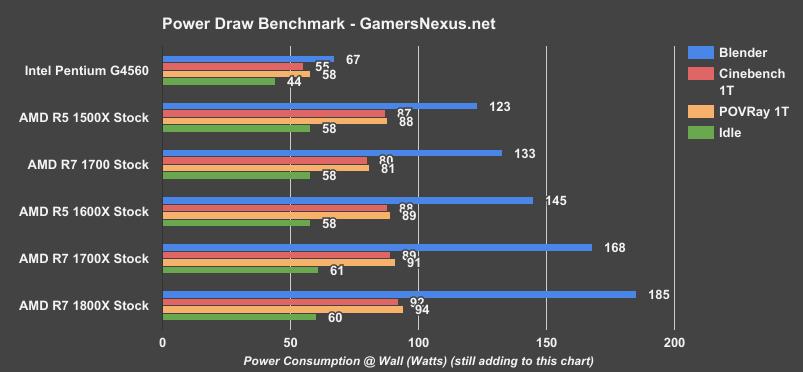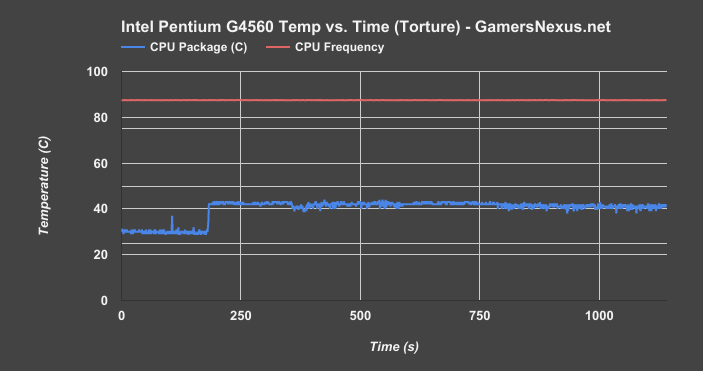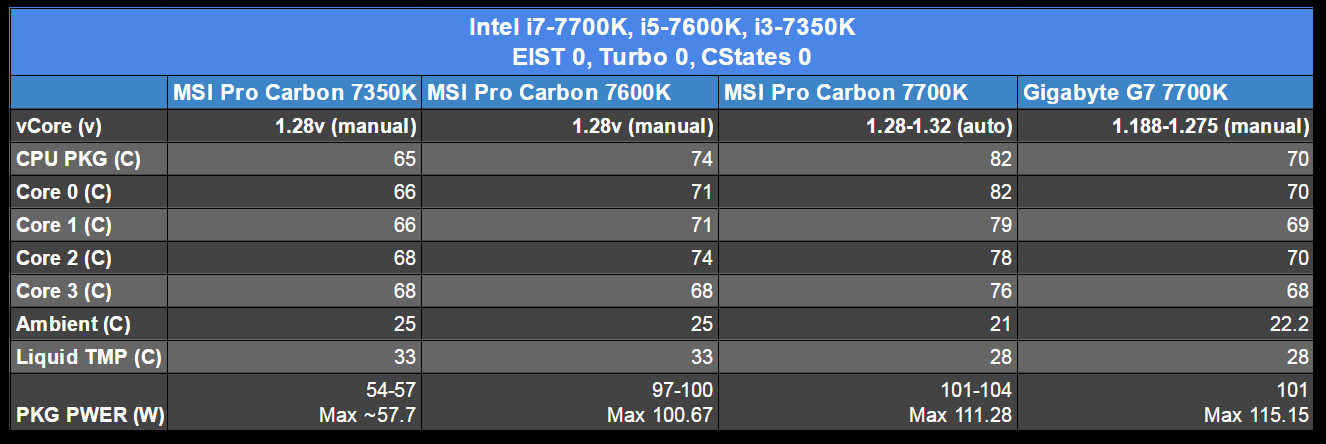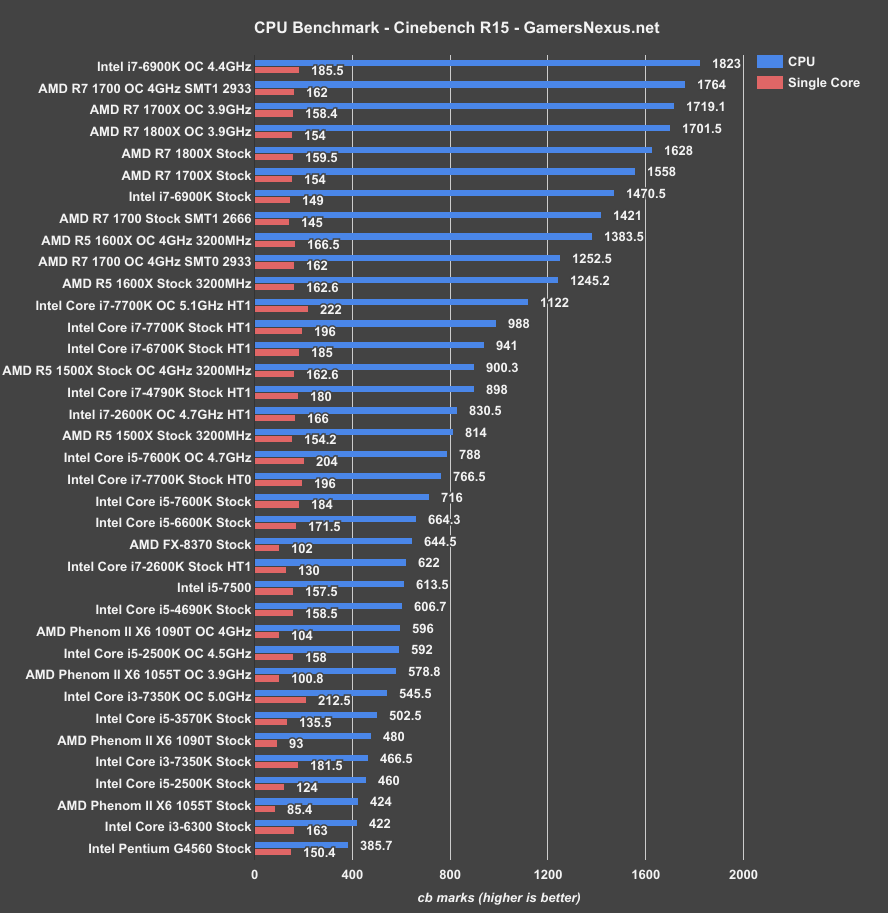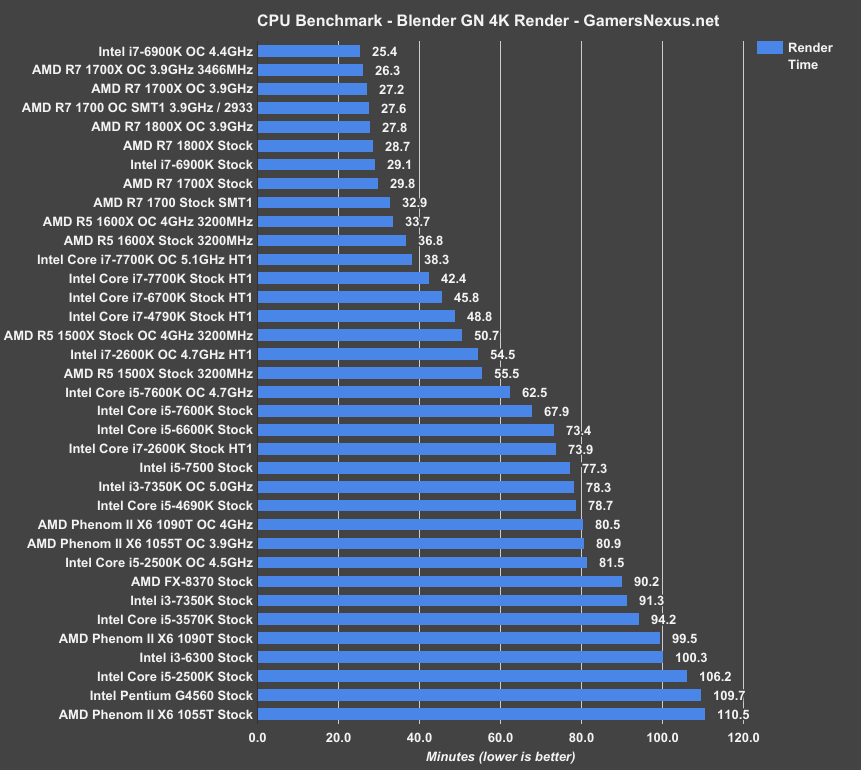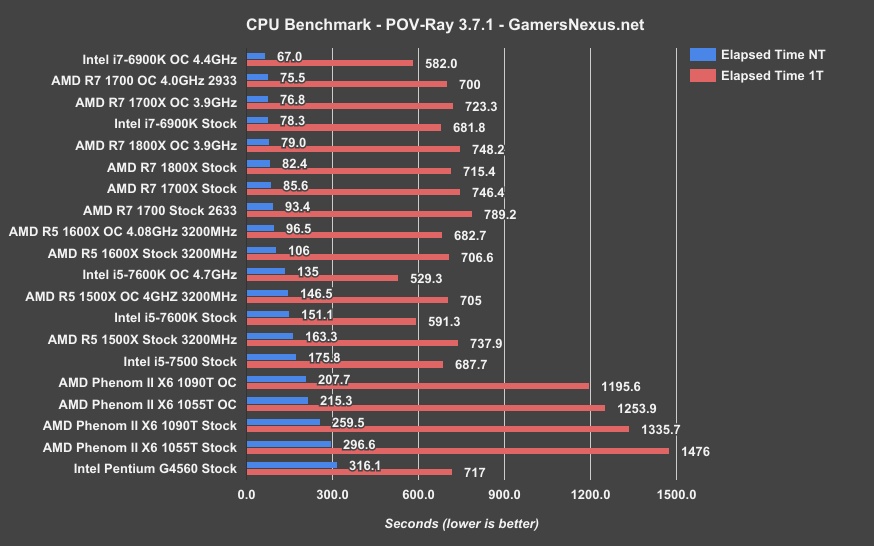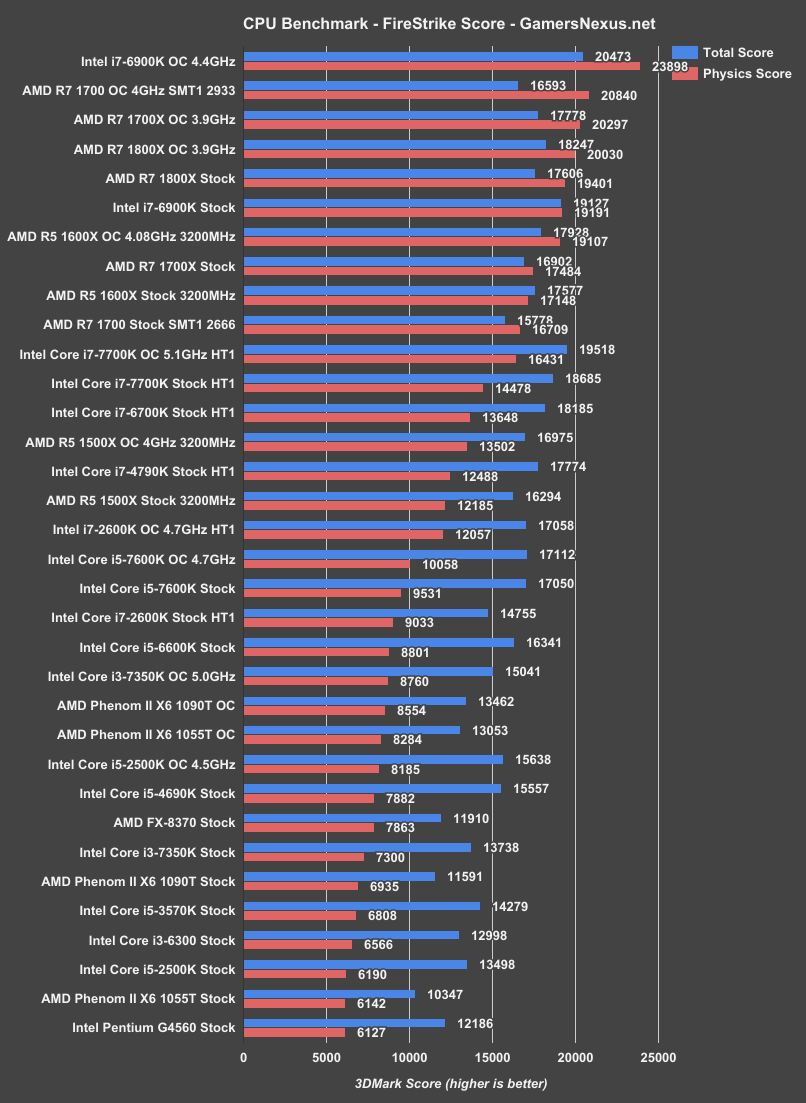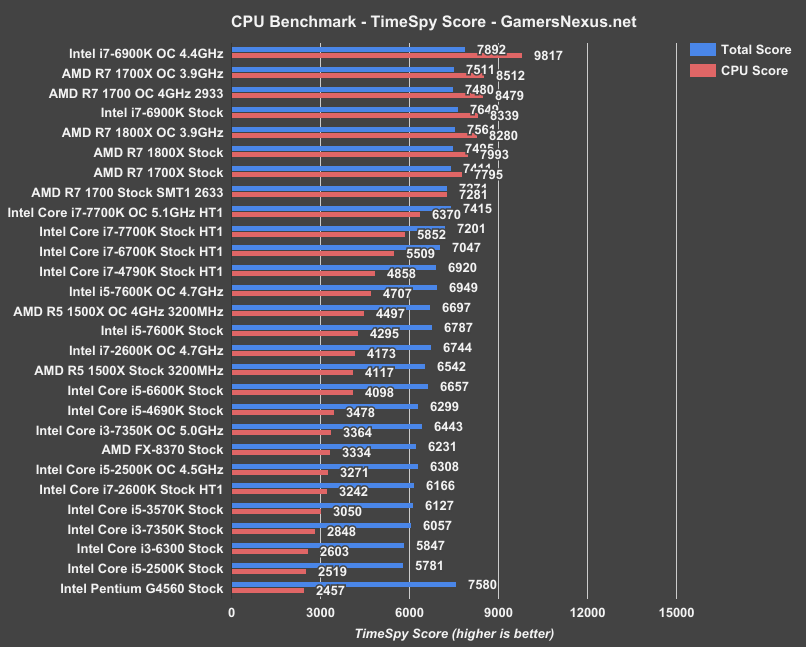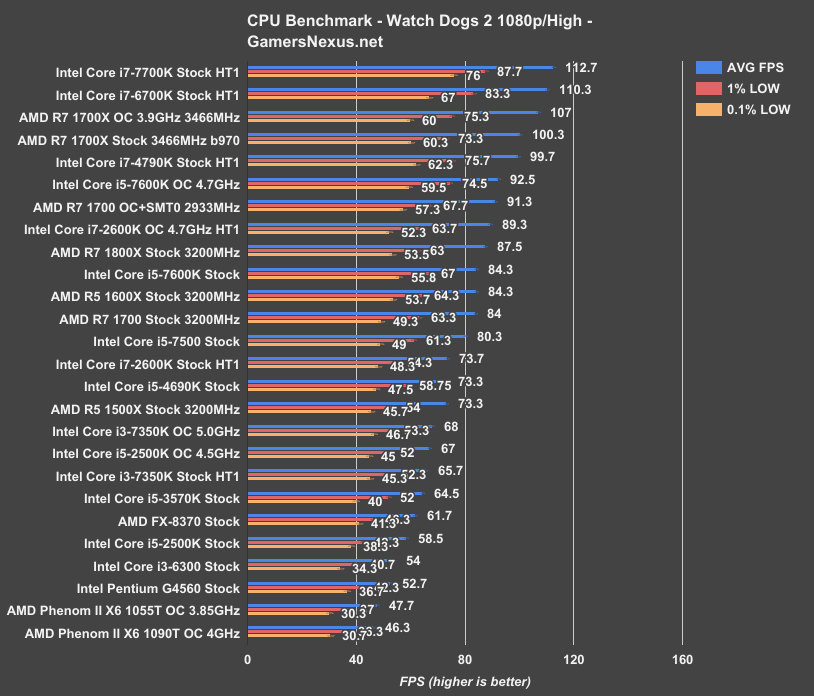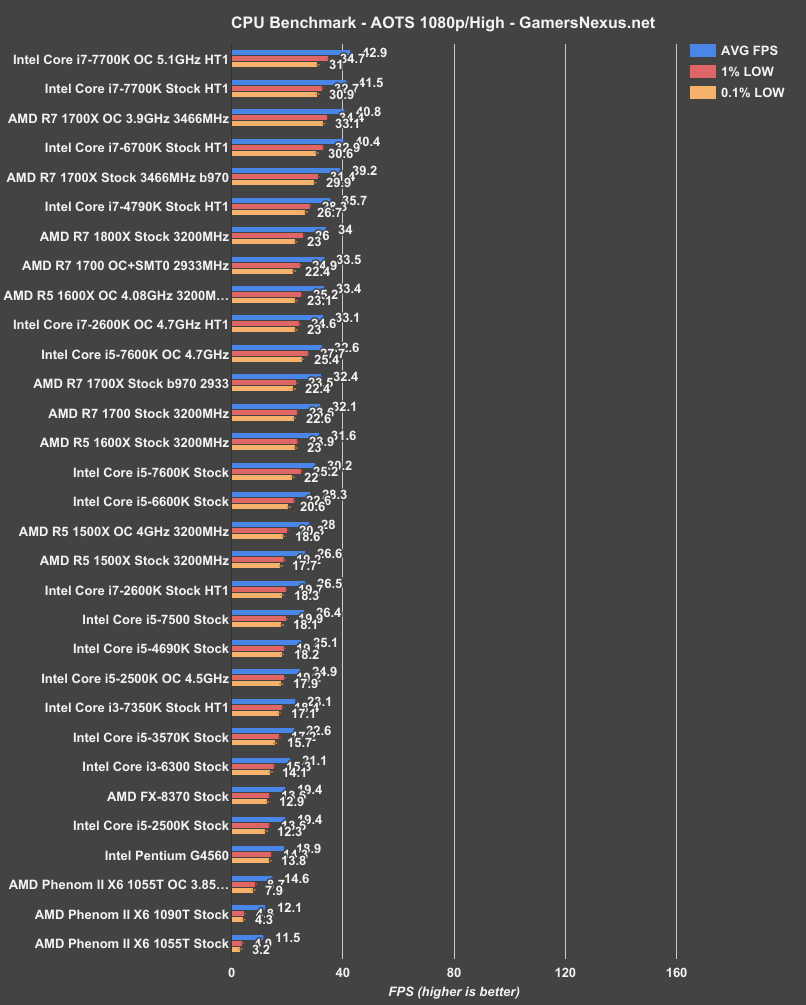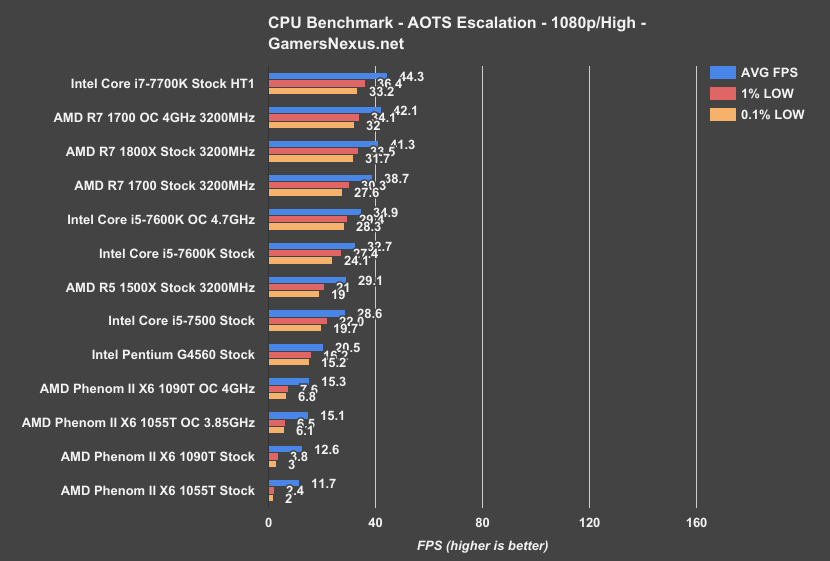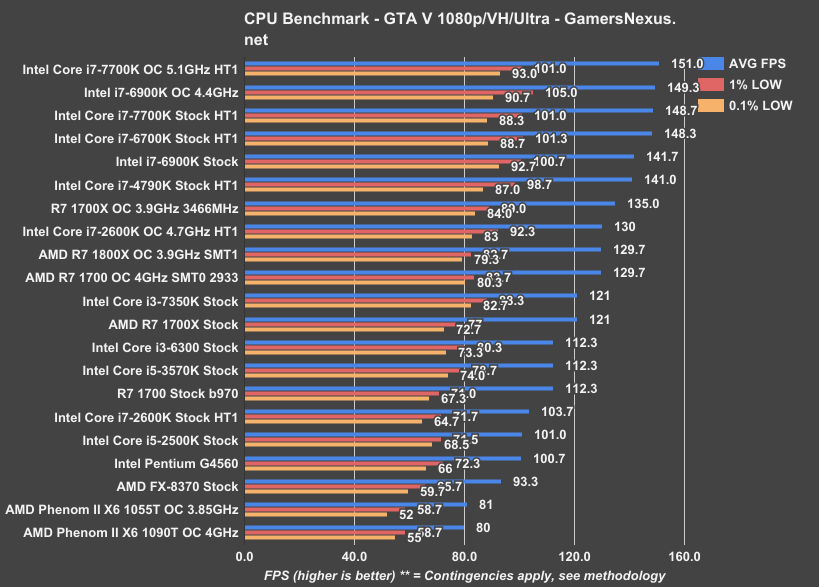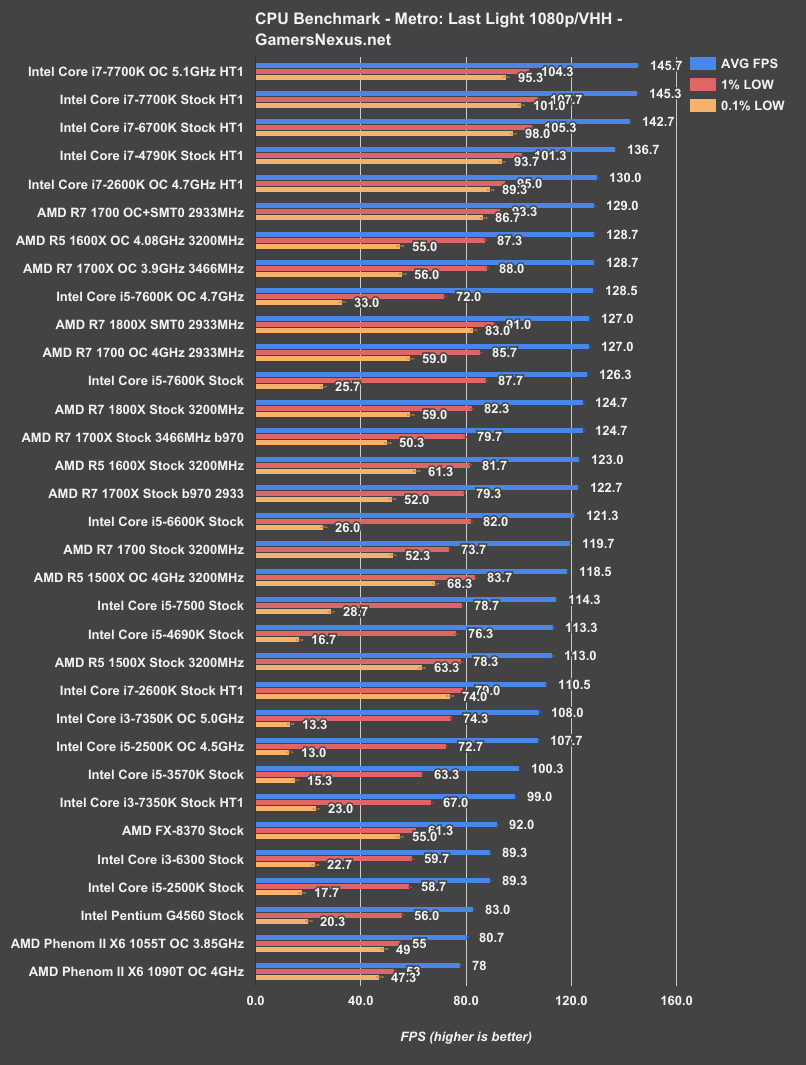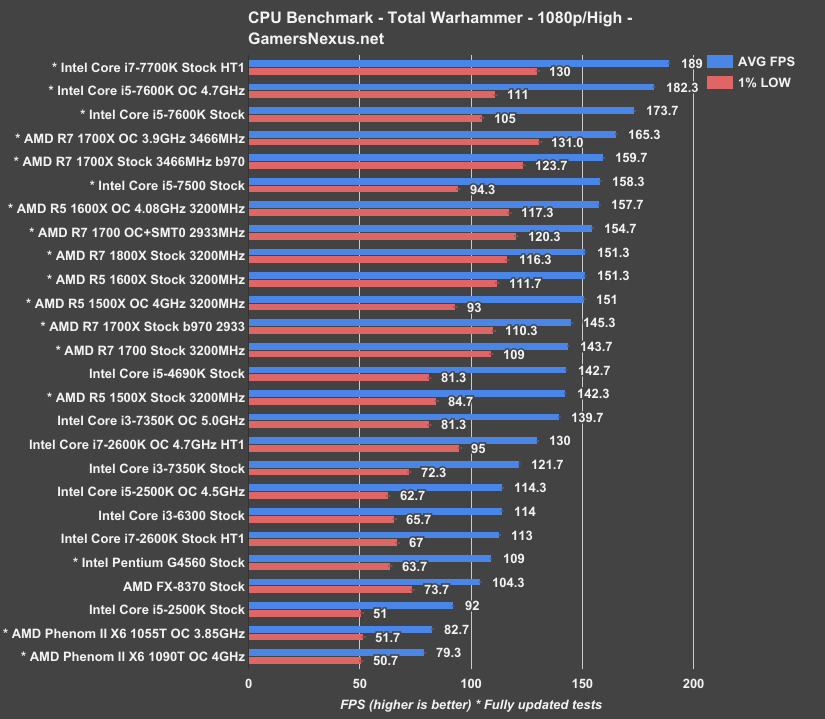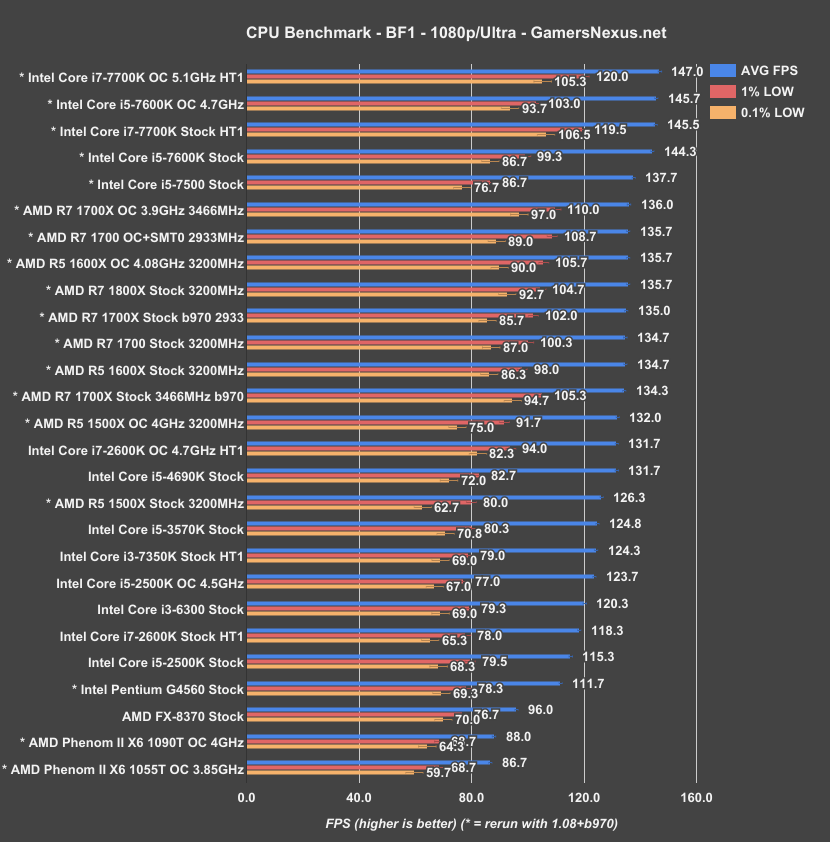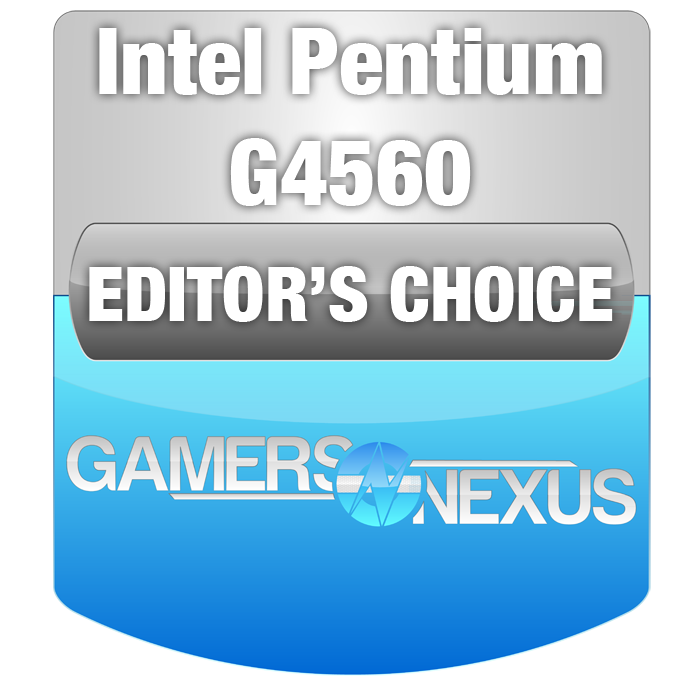Intel’s i3/i5/i7 and AMD’s R5/R7 CPUs are the big competitors in the PC gaming world, but they aren’t the only options out there: AMD released cheap but capable Athlon X4s in 2016, and in January of this year Intel released the 2C/4T Pentium G4560 ($70), a 14nm Kaby Lake processor for ~$64~$70. We didn’t fully review the older and (briefly) popular Pentium G3258, but it has showed up in Ask GN and individual benchmarks, so we were excited to do comprehensive testing on this modern iteration.
The G4560 lacks the feature that made the G3258 so popular: the ability to overclock. Buying a dirt-cheap dual-core processor and cranking the frequency up was enough for decent performance in limited-thread games, although the G3258 often suffers from extreme stuttering in more modern titles. The limitations lead us to believe that Intel doesn’t want to compete with its own more expensive 2C/4T unlocked i3 and locked i3-7100 ($120) & 7300 ($150).
Intel Pentium G4560 Specs
| G4560 | |
| Cores | 2C/4T |
| Frequency | 3.5GHz |
| Overclocking | No |
| IGP | HD 610 |
| Dynamic IGP Frequency | 1050MHz |
| TDP | 54W |
| Cache | 3MB |
| DDR4/DDR3L MHz | 2400/1600 |
| Socket | LGA1151 |
| MSRP | $64 |
The Intel Pentium G4560 is a ~$70 CPU that operates a frequency of 3.5GHz fixed, with no Turbo support. It’s also got a weaker IGP in it than nearby i3 alternatives – though we’re ignoring that, as it’s not something we recommend using for our audience. The CPU sockets into modern Kaby Lake-ready motherboards with LGA1151 socket types, meaning that you could purchase a higher-end board and later upgrade to an i5/i7-class CPU. A bit of an odd approach, but doable.
The CPU’s frequency is about 11% slower than the i3-7100 at 3.9GHz, with both CPUs carrying equal 3MB cache and stock heatsinks. Given the price disparity of $70 versus $120 for a 7100, or $150 for a 7300, the G4560 is poised to embattle Intel’s own i3 line with its Pentium-class chips, while the i5s fight a losing battle against the R5s, and the i7 consumer CPUs hold strong for gaming.
Intel’s G4560 positioning is promising for budget gaming machines, as we’ll find out in these tests, and would likely couple best with something like an RX 560, GTX 1050, or similar sub-$200 GPU. If not hoping to upgrade the CPU to another KBL part later, more savings can be had on B250 (or similar) motherboards with more conservative chipsets.
CPU Testing Methodology
GAME TEST METHODOLOGY
NVIDIA 376.33 drivers were used for benchmarking. Game settings were manually controlled for the DUT. All games were run at presets defined in their respective charts. All other game settings are defined in respective game benchmarks, which we publish separately from GPU and CPU reviews. Our test courses, in the event manual testing is executed, are also uploaded within that content. This allows others to replicate our results by studying our bench courses.
Windows 10-64 build 14393.1066 was used for testing.
Some benchmarks disable EIST, Turbo, and other features -- please check each section to learn if that is the case. Otherwise, for game benchmarks, assume stock settings (Turbo enabled). We always disable C-states.
Average FPS, 1% low, and 0.1% low times are measured. We do not report maximum or minimum FPS results as we consider these numbers to be pure outliers. Instead, we take an average of the lowest 1% of results (1% low) to show real-world, noticeable dips; we then take an average of the lowest 0.1% of results for severe spikes. GN originally coined the phrases “1% LOWs” and “0.1% LOWs” for these metrics.
EVGA Supernova 750 G2L 80+ Gold
HyperX Savage 32GB 2400MHz (4x8GB)
Corsair Force LE 240GB SSD
Open Air Test Bench
Kraken X62
EVGA GeForce GTX 1080 FTW
Note: fan and pump settings are configured on a per-test basis.
970 (RD9x0) Platform:
-ASUS 970 PRO GAMING/AURA
-Phenom II X6 1055T (125W TDP)
-Phenom II X6 1090T
Core Components (Unchanging)
- NZXT 1200W Hale90v2
- For DDR4 platforms: Corsair Vengeance LPX 32GB 3200MHz
- For DDR3 platforms: HyperX Savage 32GB 2400MHz (note: only 2133MHz was supported on our SNB platform)
- Intel 730 480GB SSD
- Open Air Test Bench
- Cooler #1 (Air): Be Quiet! Dark Rock 3
- Cooler #2 (Cheap liquid): Asetek 570LC w/ Gentle Typhoon fan (this is the one we used for this particular article)
- Cooler #3 (High-end): Kraken X62
- Video Card: EVGA GTX 1080 FTW1
- Note: fan and pump settings are configured on a per-test basis.
Z270 Platforms:
- MSI Gaming Pro Carbon
- i7-7700K (x2) samples from motherboard vendors
- i5-7600K purchased by GN
Z170 Platform:
- MSI Gaming M7
- i7-6700K retail
- i5-6600K
Z97 Platform:
- Gigabyte Z97X G1 WIFI-BK
- i7-4790K
- i5-4690K
Z77 Platform:
- MSI GD65 Z77
- i7-2600K
- i5-2500K
- i5 3570K
AM4 platform:
- ASUS Crosshair VI
Dx12 games are benchmarked using PresentMon onPresent, with further data analysis from GN-made tools.
Continue to Page 2 for power testing, temperatures, and Blender.
Intel G4560 Power Draw
Starting off with something easy, we’re looking at power draw measured from the wall. This is total system power under stock configurations, unless otherwise noted. We only just started adding these tests with Ryzen, so we’ve not yet compiled other Intel CPUs into the power draw tests. This gives us a baseline, at least.
Under no workload at all, we measured an idle power draw of 44W, placing the G4560 below all of the other CPUs we’ve recently tested – which makes sense, as it’s not a performance part. With Blender multi-threaded workload hammering all the threads, the power draw goes up to about 67W from the wall. Cinebench puts us at 55W under single-threaded conditions, with POVRay hovering at 58W under single-threaded conditions. This is all achievable thanks to roughly 1v on the core.
This is exceptionally power efficient and means that we won’t need a heavy-duty cooler for use in real-world builds. As we show in the article, you could get along just fine with the stock cooler and save even more money off the build. For temperature values, see the article linked in the description below. We’ll move on to Blender tests now.
Temperatures
The temperature of the CPU package never passed 44C, and never 18.6C above ambient. For comparison, the i3-7350K reached about 65C under load (with the same X62 cooler). The power draw (shown above) is low enough that Intel’s included stock cooler would be completely adequate for cooling, which matters a lot for a CPU so cheap that a $20 cooler would be nearly one-third of its cost.
7350K temperatures, for comparison:
Synthetic Benchmarks
Cinebench - Intel G4560 Results vs. i3, i5, R5
Multithreaded, 385.7 is the worst average score in our current database. Single-threaded, 150.4 is fairly respectable, and that competence in limited-thread applications is what will matter later on in gaming benchmarks. 150 is on par with lower-frequency modern processors like the 6900K and 1700X, although they have a massive advantage in core count to compensate.
The i3-6300, for reference, operated 9% faster than the G4560 at 422 cb marks, and 8.3% faster in single-threaded performance. That makes sense, given the clock difference. For more reference points, the i3-7350K stock CPU scored 467cb marks, or a 21% lead over the G4560 as gained by an extra $100 spend.
Blender - Intel G4560 Render Benchmark
Blender took 109.7 minutes to complete rendering, almost exactly as long as the stock Phenom II X6 1055T, a CPU that recently celebrated its seventh birthday. Based on this, we decided to again forgo the even-longer Premiere render test. Overclocked, the 7350K finished in only 78.3 minutes, but this is only a theoretical advantage: nobody that can avoid it should be attempting to render scenes using a dual-core processor.
For what it’s worth, the i3-6300 completed the render in 100 minutes, roughly 10% ahead of the G4560. That’s the advantage of a faster clock.
POV-Ray Benchmark - Intel G4560
Similar to Cinebench, POV-Ray’s multithreaded benchmark was well beyond the capabilities of the G4560, coming in behind the stock 1055T again, and in single-threaded performance roughly equal to modern processors like the 1800X. Still, the 1800X can be overclocked, and the G4560 cannot.
3DMark Firestrike & Timespy - G4560
A 6127 physics score in Firestrike is lower than both stock Phenom IIs and 30% lower than the overclocked 7350K, but at least the TimeSpy benchmark actually completed, which is more than the Phenom IIs could manage. In TimeSpy, the score is 27% below the 7350K OC.
Synthetics are a weak spot. The G4560 is absolutely, positively not suited for rendering or heavily-threaded tasks, even less so than i5s, since it only has two physical cores and a heavily limited frequency. We include these results to be thorough, but they don’t represent the intended use of this processor. Note that although the G4560 firmly places itself at the bottom of the chart in every single multithreaded synthetic test, the single-threaded results are not bad.
Continue to the next page for gaming benchmarks & the conclusion.
Gaming Benchmarks
Watch Dogs 2 CPU Benchmark - Intel G4560
Watch Dogs 2 places the Intel Pentium G4560 at around 53FPS AVG, with 1% lows at 42 and GN’s 0.1% lows at 37FPS AVG. Considering we’re operating with High settings, this isn’t too bad – and we’ve got a Watch Dogs 2 tuning guide for geometry reductions to help save on performance, if that’s needed. But we’re not testing in a vacuum. Versus the Intel i3-6300, which we purchased last year for $145, the G4560 is nearly equal in performance – it’s a difference of about 2% in average FPS. We don’t have the i3-7100 or 7300, but the i3-6300 is only a few percentage points different in performance from either of these – the $120 i3-7100 clocks at 3.9GHz, making it 11% faster in frequency than the 3.5GHz G4560, and the i3-7300 clocks at 4.0GHz and costs $150. To be fair, the 7400 also has an extra megabyte of cache, but it’s also about 2x the cost of the G4560.
Regardless, we do have the 7350K stock CPU with its higher base and boost, and that one holds a lead of about 25% over the one-third-the-cost G4560. The G4560, with its i3-6300-matching performance, looks to be a good deal so far. This is somewhat reminiscent of the G3258, but better. It is a challenger to Intel’s own i3 market, with performance levels comparable to a 2500K.
Just for some perspective, we’ll highlight the i5-7500 and the R5 1500X. Respectively, these chips run averages that are 52% and 39% faster than the G4560. That said, if you’re going to be on a tight budget where high-end GPUs are not possible, the gains aren’t going to actually matter until a point where the GPU becomes powerful enough to push into bottleneck territory.
Ashes of the Singularity & Escalation - G4560 Benchmark
The AOTS and Escalation benchmarks completed flawlessly this time, again unlike the Phenom IIs. Predictably, the G4560 scored poorly in both, although results look less favorable in Escalation due to limited data. 18.9 FPS is nearly as good as the stock 2500K and the FX-8370, but the 0.1% low is (slightly) higher than both. Ashes of the Singularity is a DX12 benchmark optimized for high-threadcount CPUs, though, and the G4560 is certainly not that.
GTA V CPU Benchmark - Intel G4560 vs. i3
Playing GTA V at 1080p and with Very High and Ultra settings, the Intel Pentium G4560 operates an average FPS of 101, with GN 1% lows at 72 and 0.1% lows at 66FPS. This leads the CPU to be flanked by the FX-8370 and i5-2500K stock CPUs, with the G4560 mostly tied to the latter and outperforming the former by 7.9%.
The more SKU-comparable i3-6300, meanwhile, runs an average FPS of 112, with 1% lows at 80 and 0.1% lows at 73. The 6300 is about 11.5% faster than the G4560, here, showing some meaningful gains in this particular game. The i3-7350K, for what it’s worth, runs its averages stock at 121FPS, leading the G4560 by 20% in performance. Overclocking the i3-7350K doesn’t appear here, as it encounters the same GTA V issue that we’ve been profiling throughout the first quarter.
With an adequate GPU, GTA V is completely playable on a CPU with an MSRP $4 higher than the game itself on Steam.
Metro: Last Light CPU Benchmark - Intel Pentium G4560
Metro was the only test that visibly stuttered more than expected. The uncharacteristically low 0.1% and 1% lows reflect this, although the average is normal. The i3-7350K experienced similar issues to an even greater degree, and we chose not to include those results in the final review. The same effect is visible on many of the other i5s, i3s, and HT-disabled i7s that we’ve tested, i.e. CPUs with fewer than 8 threads.
Total War: Warhammer CPU Benchmark - Intel Pentium G4560
Keep in mind that Total War: Warhammer received an update back during our Ryzen Revisit, improving the game’s frametime performance and consistency on both Intel CPUs and Ryzen CPUs. Only the line items with asterisks have thus far been updated, so we need to rerun some of the lower-end Intel CPUs. That said, the difference in averages is a couple percent at best; this update was really something that primarily affected 0.1% low performance and AMD SMT performance.
That made clear, the Intel Pentium G4560 operates at 109FPS AVG in Total War: Warhammer, with its lows at 64FPS. We are approaching performance levels of the i3-6300 CPU at 114FPS AVG and 66FPS 1% lows, with the i3-6300 running about 4.6% faster than the G4560, despite its initial cost of $145. The i3-7100 and 7300 would perform similarly to the 6300, with a couple percent gain on the 7300.
The Intel i3-7350K stock CPU operates an average framerate of about 122FPS, leading the G4560 by about 12% in performance, and leading by about 2.5x in price.
Again with this game, as long as you’re not going to be running a GPU of $200+ class anyway, there’s not a huge concern of bottlenecking.
Battlefield 1 CPU Benchmark - Intel Pentium G4560
Finally, Battlefield 1 will round-out our testing for the video, with the rest of the benchmarks taking place in the article linked in the description below.
The Intel Pentium G4560 is able to handle our Battlefield 1 test at 112FPS AVG, but keep in mind that 64-slot servers with a large amount of actors near the player will linearly drive numbers down. Ultimately, we’re just looking at deltas between parts, anyway.
So, 112 – that puts us fairly close to the i5-2500K stock CPU, again ahead of the FX-8370 CPU, and puts the i3-6300 about 7.7% ahead of the Pentium G4560. These gains for the i3s would be reasonable, except the price makes it sort of a tough argument – price jumps of $50 minimum, $70 for the 6300 and 7300 line, and gains of under 10%. Considering someone in this price bracket is on a tight budget, the $50 or $70 would better go toward other components.
Conclusion: Intel Pentium G4560 Value Exceeds i3-Class
In gaming, the closest equivalent seems to be the stock i5-2500K, which we just revisited. For a more modern comparison, something like the i3-6300 (comparable to the i3-7100 and, although it has more cache, i3-7300) perform not too distantly from the G4560. Considering the price disparity is about 2x versus the i3-class CPUs for a ~10% gain (ignoring the 7350K), we cannot reasonably recommend the Intel i3 line for gaming at this time. Intel’s armor is starting to crack: The i5 range is under heavy assault by R5 CPUs (like the R5 1600 - $220), which we now recommend in most cases, with HEDT thoroughly challenged by lower-cost R7 CPUs. Intel holds its ground in two places, now: The absolute high-end for gaming-only builds, where the i7-7700K remains uncontested, and the absolute low-end for gaming-only builds, where the G4560 takes shots at Intel’s own i3 CPUs.
We shouldn’t even get started on the 7350K, really, seeing as we already remarked on its “good idea plagued with bad price” model in our review: i3-7350Ks are going for $170 on Newegg at the time of this writing (ostensibly on sale), a whopping 2.65x of the G4560’s MSRP.
For pure gaming, the price-to-performance ratio is truly impressive: paired with an inexpensive GPU like a GTX 1050 ($110) or forthcoming RX 560, it can run new games at 1080p/High readily. There are at least a couple other use cases: the very low temperatures and compatibility with modern hardware make it a possible candidate for a cheap small form factor PC, the LGA 1151 socket means that it could be used as an inexpensive placeholder for a better processor. The integrated GPU, which we don’t typically test as a gaming-centric site, means that a functional system could be built for $65 plus the cost of a motherboard and PSU and upgraded later.
Two cores and no capacity for overclocking limit its useful lifespan in the AAA gaming realm, but at the end of the day, $65 is about as cheap as a brand-new processor gets. The competition from Intel is mainly their low-end i3 CPUs. Ignore the 7350K -- we felt that it was priced a bit too high at the time, and in that respect the G4560 clearly wins out. For a budget with hard limits, this is a good fit.
Editorial: Patrick Lathan & Steve Burke
Video Producer: Andrew Coleman
